Electrosynthesis and Characterization of Novel CNx-HMMT Supported Pd Nanocomposite Material for Methanol Electro-Oxidation
Abstract
:1. Introduction
2. Materials and Methods
2.1. Materials and Apparatus
2.2. Synthesis of Pd-CNx-HMMT Composite Electrode
2.2.1. Acid Activation
2.2.2. Synthesis of PANI/HMMT Nanocomposites
2.2.3. Preparation of CNx-HMMT
2.2.4. Fabrication of Pd/CNx-HMMT Thin-Film Electrode
2.3. Characterization Techniques
2.3.1. Fourier Transform Infrared Spectroscopy (FTIR)
2.3.2. X-ray Diffraction Measurements (XRD)
2.3.3. Scanning Electron Microscopy (SEM) and Transmission Electron Microscopy (TEM)
2.3.4. Cyclic Voltammetry (CV)
3. Results and Discussion
3.1. FTIR Spectroscopy
3.2. X-ray Diffraction
3.3. Morphological Analysis
3.4. Cyclic Voltammograms (CVs)
3.5. Methanol Oxidation
4. Conclusions
Author Contributions
Funding
Institutional Review Board Statement
Informed Consent Statement
Data Availability Statement
Acknowledgments
Conflicts of Interest
References
- Gong, L.; Yang, Z.; Li, K.; Xing, W.; Liu, C.; Ge, J. Recent development of methanol electrooxidation catalysts for direct methanol fuel cell. J. Energy Chem. 2018, 27, 1618–1628. [Google Scholar] [CrossRef]
- Berber, M.R.; Fujigaya, T.; Nakashima, N. A potential polymer formulation of a durable carbon-black catalyst with a significant fuel cell performance over a wide operating temperature range. Mater. Today Energy 2018, 10, 161–168. [Google Scholar] [CrossRef]
- Devi, A.U.; Divya, K.; Rana, D.; Saraswathi, M.S.A.; Nagendran, A. Highly selective and methanol resistant polypyrrole laminated SPVdF-co-HFP/PWA proton exchange membranes for DMFC applications. Mater. Chem. Phys. 2018, 212, 533–542. [Google Scholar] [CrossRef]
- Hu, Q.-Y.; Luo, L.-M.; Zhang, R.-H.; Chen, D.; Guo, Y.-F.; Zhan, W.; Zhou, X.W. Hydrothermal synthesis of complex morphological bimetal PdRh nanocatalysts for methanol oxidation. J. Alloy. Compd. 2020, 818, 152886. [Google Scholar] [CrossRef]
- Ojani, R.; Hasheminejad, E.; Raoof, J.B. Direct growth of 3D flower-like Pt nanostructures by a template-free electrochemical route as an efficient electrocatalyst for methanol oxidation reaction. Energy 2015, 90, 1122–1131. [Google Scholar] [CrossRef]
- Xie, Y.; Li, Z.; Liu, Y.; Ye, Y.; Zou, X.; Lin, S. Plasmon enhanced bifunctional electro-photo catalytic properties of Pt-Au/graphene composites for methanol oxidation and oxygen reduction reaction. Appl. Surface Sci. 2020, 508, 145161. [Google Scholar] [CrossRef]
- Shahrokhian, S.; Rezaee, S. Vertically standing Cu2O nanosheets promoted flower-like PtPd nanostructures supported on reduced graphene oxide for methanol electro-oxidation. Electrochim. Acta 2018, 259, 36–47. [Google Scholar] [CrossRef]
- Soleimani-Lashkenari, M.; Rezaei, S.; Fallah, J.; Rostami, H. Electrocatalytic performance of Pd/PANI/TiO2 nanocomposites for methanol electrooxidation in alkaline media. Synth. Met. 2018, 235, 71–79. [Google Scholar] [CrossRef]
- Wang, Z.-B.; Zuo, P.-J.; Wang, G.-J.; Du, C.-Y.; Yin, G.-P. Effect of Ni on PtRu/C catalyst performance for ethanol electrooxidation in acidic medium. J. Phys. Chem. C 2008, 112, 6582–6587. [Google Scholar] [CrossRef]
- Kwok, Y.; Wang, Y.; Tsang, A.C.; Leung, D.Y. Graphene-carbon nanotube composite aerogel with Ru@ Pt nanoparticle as a porous electrode for direct methanol microfluidic fuel cell. Appl. Energy 2018, 217, 258–265. [Google Scholar] [CrossRef]
- Hanifah, M.F.R.; Jaafar, J.; Othman, M.; Ismail, A.; Rahman, M.; Yusof, N.; Aziz, F. One-pot synthesis of efficient reduced graphene oxide supported binary Pt-Pd alloy nanoparticles as superior electro-catalyst and its electro-catalytic performance toward methanol electro-oxidation reaction in direct methanol fuel cell. J. Alloy. Compd. 2019, 793, 232–246. [Google Scholar] [CrossRef]
- Ren, J.; Zhang, J.; Yang, C.; Yang, Y.; Zhang, Y.; Yang, F.; Ma, F.; Yang, L.; He, H.; Huang, H. Pd nanocrystals anchored on 3D hybrid architectures constructed from nitrogen-doped graphene and low-defect carbon nanotube as high-performance multifunctional electrocatalysts for formic acid and methanol oxidation. Mater. Today Energy 2020, 16, 100409. [Google Scholar] [CrossRef]
- Kang, Z.; Zhao, M.; Wu, Y.; Xia, T.; Cao, J.-P.; Cai, W.; Chen, L. Facial fabrication of yolk-shell Pd-Ni-P alloy with mesoporous structure as an advanced catalyst for methanol electro-oxidation. Appl. Surface Sci. 2019, 484, 441–445. [Google Scholar] [CrossRef]
- Zhao, Y.; Zhan, L.; Tian, J.; Nie, S.; Ning, Z. Enhanced electrocatalytic oxidation of methanol on Pd/polypyrrole–graphene in alkaline medium. Electrochim. Acta 2011, 56, 1967–1972. [Google Scholar] [CrossRef]
- Chen, D.; He, Z.; Pei, S.E.; Huang, L.A.; Shao, H.; Jin, Y.; Wang, J. Pd nanoparticles supported on N and P dual-doped graphene as an excellent composite catalyst for methanol electro-oxidation. J. Alloy. Compd. 2019, 785, 781–788. [Google Scholar] [CrossRef]
- Ruiz-Garcia, C.; Heras, F.; Calvo, L.; Alonso-Morales, N.; Rodriguez, J.; Gilarranz, M. Improving the activity in hydrodechlorination of Pd/C catalysts by nitrogen doping of activated carbon supports. J. Environ. Chem. Eng. 2020, 8, 103689. [Google Scholar] [CrossRef]
- Wang, W.-D.; Lin, X.-Q.; Zhao, H.-B.; Lü, Q.-F. Nitrogen-doped graphene prepared by pyrolysis of graphene oxide/polyaniline composites as supercapacitor electrodes. J. Anal. Appl. Pyrolysis 2016, 120, 27–36. [Google Scholar] [CrossRef]
- Vinayan, B.; Sethupathi, K.; Ramaprabhu, S. Facile synthesis of triangular shaped palladium nanoparticles decorated nitrogen doped graphene and their catalytic study for renewable energy applications. Int. J. Hydrog. Energy 2013, 38, 2240–2250. [Google Scholar] [CrossRef]
- Asensio, J.A.; Borrós, S.; Gómez-Romero, P. Proton-conducting polymers based on benzimidazoles and sulfonated benzimidazoles. J. Polym. Sci. Part A Polym. Chem. 2002, 40, 3703–3710. [Google Scholar] [CrossRef] [Green Version]
- Pan, Y.B.; Shen, X.C.; Yao, L.B.; Bentalib, A.; Peng, Z.M. Active sites in heterogeneous catalytic reaction on metal and metal oxide: Theory and practice. Catalysts 2018, 8, 478. [Google Scholar] [CrossRef] [Green Version]
- Lippits, M.J.; Nieuwenhuys, B.E.; Iwema, R.R.H.B. A comparative study of oxidation of methanol on gamma-Al2O3 supported group IB metal catalysts. Catal. Today 2009, 145, 27–33. [Google Scholar] [CrossRef]
- Kai, L.; Xuezhong, W.; Zexing, Z.; Xiaodong, W.; Duan, W. Oxygen storage capacity of Pt-, Pd-, Rh/CeO2-based oxide catalyst. J. Rare Earths 2017, 25, 6–10. [Google Scholar] [CrossRef]
- Zhang, X.; Chen, X.; Liu, Y.; Guo, M. Effects of Support on Performance of Methanol Oxidation over Palladium-Only Catalysts. Water Air Soil Pollut. 2020, 231, 277. [Google Scholar] [CrossRef]
- Hrachová, J.; Komadel, P.; Fajnor, V.Š. The effect of mechanical treatment on the structure of montmorillonite. Mater. Lett. 2007, 61, 3361–3365. [Google Scholar] [CrossRef]
- Wang, J.; Sun, K.; Hao, W.; Du, Y.; Pan, C. Structure, and properties research on montmorillonite modified by flame-retardant dendrimer. Appl. Clay Sci. 2014, 90, 109–121. [Google Scholar] [CrossRef]
- Herrero, M.; Núñez, K.; Gallego, R.; Merino, J.C.; Pastor, J.M. Control of molecular weight and polydispersity in polyethylene/needle-like shaped clay nanocomposites obtained by in situ polymerization with metallocene catalysts. Eur. Polym. J. 2016, 75, 125–141. [Google Scholar] [CrossRef]
- Manikandan, D.; Divakar, D.; Rupa, A.V.; Revathi, S.; Preethi, M.E.L.; Sivakumar, T. Synthesis of platinum nanoparticles in montmorillonite and their catalytic behaviour. Appl. Clay Sci. 2007, 37, 193–200. [Google Scholar] [CrossRef]
- Wang, J.; Zhu, Q.; Lu, X.; Meng, Y. ZnGA–MMT catalyzed the copolymerization of carbon dioxide with propylene oxide. Eur. Polym. J. 2005, 41, 1108–1114. [Google Scholar] [CrossRef]
- Brankovic, S.R.; Zangari, G. Electrochemical Surface Processes and Opportunities for Material Synthesis. Electrochem. Eng. Across Scales Mol. Process. 2015. [Google Scholar] [CrossRef]
- Zangari, G. Electrodeposition of alloys and compounds in the era of microelectronics and energy conversion technology. Coatings 2015, 5, 195–218. [Google Scholar] [CrossRef]
- Tiwari, A.K.; Jain, S.; Mungray, A.A.; Mungray, A.K. SnO2: PANI modified cathode for performance enhancement of air-cathode microbial fuel cell. J. Environ. Chem. Eng. 2020, 8, 103590. [Google Scholar] [CrossRef]
- Pattanayak, P.; Pramanik, N.; Papiya, F.; Kumar, V.; Kundu, P.P. Metal-free keratin modified poly (pyrrole-co-aniline)-reduced graphene oxide-based nanocomposite materials: A promising cathode catalyst in microbial fuel cell application. J. Environ. Chem. Eng. 2020, 8, 103813. [Google Scholar] [CrossRef]
- Ndé, H.S.; Tamfuh, P.A.; Clet, G.; Vieillard, J.; Mbognou, M.T.; Woumfo, E.D. Comparison of HCl and H2SO4 for the acid activation of a cameroonian smectite soil clay: Palm oil discolouration and landfill leachate treatment. Heliyon 2019, 5, e02926. [Google Scholar] [CrossRef] [PubMed] [Green Version]
- Abbas, M.; Hachemaoui, A.; Yahiaoui, A.; Mourad, A.-H.I.; Belfedal, A.; Cherupurakal, N. Chemical synthesis of nanocomposites via in-situ polymerization of aniline and iodoaniline using exchanged montmorillonite. Polym. Polym. Compos. 2020. [Google Scholar] [CrossRef]
- Kalotra, S.; Mehta, R. Synthesis of polyaniline/clay nanocomposites by in situ polymerization and its application for the removal of Acid Green 25 dye from wastewater. Polym. Bull. 2020, 78, 2439–2463. [Google Scholar] [CrossRef]
- Kenane, A.; Galca, A.-C.; Matei, E.; Yahiaoui, A.; Hachemaoui, A.; Benkouider, A.M.; Bartha, C.; Istrate, M.C.; Galatanu, M.; Stanculescu, A.; et al. Synthesis and characterization of conducting aniline and o-anisidine nanocomposites based on montmorillonite modified clay. Appl. Clay Sci. 2020, 184, 105395. [Google Scholar] [CrossRef]
- Goldstein, J.I.; Newbury, D.E.; Michael, J.R.; Ritchie, N.W.; Scott, J.H.J.; Joy, D.C. Scanning Electron Microscopy and X-ray Microanalysis; Springer: Berlin/Heidelberg, Germany, 2017. [Google Scholar]
- Zhang, K.; Yang, W.; Ma, C.; Wang, Y.; Sun, C.; Chen, Y.; Chen, L.; Duchesne, P.; Zhou, J.; Wang, J.; et al. A highly active, stable and synergistic Pt nanoparticles/Mo 2 C nanotube catalyst for methanol electro-oxidation. NPG Asia Mater. 2015, 7, e153. [Google Scholar] [CrossRef]
- Lee, Y.-W.; Han, S.-B.; Park, K.-W. Electrochemical properties of Pd nanostructures in alkaline solution. Electrochem. Commun. 2009, 11, 1968–1971. [Google Scholar] [CrossRef]
- Marins, J.A.; Soares, B.G. A facile and inexpensive method for the preparation of conducting polyaniline–clay composite nanofibers. Synth. Met. 2012, 162, 2087–2094. [Google Scholar] [CrossRef]
- Zhang, Y.; Shao, Y.; Zhang, T.; Meng, G.; Wang, F. High corrosion protection of a polyaniline/organophilic montmorillonite coating for magnesium alloys. Prog. Org. Coat. 2013, 76, 804–811. [Google Scholar] [CrossRef]
- Li, Y.F.; Wang, Y.P.; Gao, X.H.; Gao, J.M. Composites of Polystyrene Sulfonic Acid (PSSA)-Polyaniline and Montmorillonite Clay: Synthesis and Characterization. J. Macromol. Sci. Part A 2006, 43, 405–415. [Google Scholar] [CrossRef]
- Abd El-Ghaffar, M.; Youssef, A.; Abd El-Hakim, A. Polyaniline nanocomposites via in situ emulsion polymerization based on montmorillonite: Preparation and characterization. Arab. J. Chem. 2015, 8, 771–779. [Google Scholar] [CrossRef] [Green Version]
- Kim, B.-H.; Jung, J.-H.; Hong, S.-H.; Joo, J.; Epstein, A.J.; Mizoguchi, K.; Kim, J.W.; Choi, H.J. Nanocomposite of polyaniline and Na+− montmorillonite clay. Macromolecules 2002, 35, 1419–1423. [Google Scholar] [CrossRef]
- Wei, Z.; Pan, R.; Hou, Y.; Yang, Y.; Liu, Y. Graphene-supported Pd catalyst for highly selective hydrogenation of resorcinol to 1, 3-cyclohexanedione through giant π-conjugate interactions. Sci. Rep. 2015, 5, 15664. [Google Scholar] [CrossRef]
- Xu, Y.; Ma, J.; Xu, Y.; Xu, L.; Xu, L.; Li, H. Palladium nanoparticles encapsulated in porous silica shells: An efficient and highly stable catalyst for CO oxidation. RSC Adv. 2013, 3, 851–858. [Google Scholar] [CrossRef]
- Lee, D.; Char, K.; Lee, S.W.; Park, Y.W. Structural changes of polyaniline/montmorillonite nanocomposites and their effects on physical properties. J. Mater. Chem. 2003, 13, 2942–2947. [Google Scholar] [CrossRef]
- Qureshi, U.A.; Gubbuk, I.H.; Ersoz, M.; Solangi, A.R.; Taqvi, S.I.; Memon, S.Q. Preparation of polyaniline montmorillonite clay composites for the removal of diethyl hexyl phthalate from aqueous solutions. Sep. Sci. Technol. 2016, 51, 214–228. [Google Scholar] [CrossRef]
- Huang, H.; Wang, X. Pd nanoparticles supported on low-defect graphene sheets: For use as high-performance electrocatalysts for formic acid and methanol oxidation. J. Mater. Chem. 2012, 22, 22533–22541. [Google Scholar] [CrossRef]
- Sun, Z.; Wang, X.; Liu, Z.; Zhang, H.; Yu, P.; Mao, L. PtRu/CeO2/carbon nanotube nanocomposites: An efficient electrocatalyst for direct methanol fuel cells. Langmuir 2010, 26, 12383–12389. [Google Scholar] [CrossRef]
- Li, Y.; Gao, W.; Ci, L.; Wang, C.; Ajayan, P.M. Catalytic performance of Pt nanoparticles on reduced graphene oxide for methanol electro-oxidation. Carbon 2010, 48, 1124–1130. [Google Scholar] [CrossRef]
- Wu, X.; Zhuang, W.; Lu, L.; Li, L.; Zhu, J.; Mu, L.; Li, W.; Zhu, Y.; Lu, X. Excellent performance of Pt-C/TiO2 for methanol oxidation: Contribution of mesopores and partially coated carbon. Appl. Surface Sci. 2017, 426, 890–896. [Google Scholar] [CrossRef] [Green Version]
- Lee, J.-M.; Han, S.-B.; Kim, J.-Y.; Lee, Y.-W.; Ko, A.R.; Roh, B.; Hwang, I.; Park, K.W. TiO2@carbon core-shell nanostructure supports for platinum and their use for methanol electrooxidation. Carbon 2010, 48, 2290–2296. [Google Scholar] [CrossRef]
- Chu, Y.-Y.; Wang, Z.-B.; Jiang, Z.-Z.; Gu, D.-M.; Yin, G.-P. A novel structural design of a Pt/C-CeO2 catalyst with improved performance for methanol electro-oxidation by cyclodextrin carbonization. Adv. Mater. 2011, 23, 3100–3104. [Google Scholar] [CrossRef]
- Haisch, T.; Kubannek, F.; Nikitina, L.; Nikitin, I.; Pott, S.; Cleesc, T.; Krewer, U. The origin of the hysteresis in cyclic voltammetric response of alkaline methanol electrooxidation. Phys. Chem. Chem. Phys. 2020, 22, 16648–16654. [Google Scholar] [CrossRef]
- Chung, D.Y.; Lee, K.-J.; Sung, Y.-E. Methanol Electro-oxidation on Pt Surface: Revisiting the Cyclic Voltammetry Intrepretation. J. Phys. Chem. C 2010, 120, 9028–9035. [Google Scholar] [CrossRef]
- Huang, H.; Yang, S.; Vajtai, R.; Wang, X.; Ajayan, P.M. Pt-decorated 3D architectures built from graphene and graphitic carbon nitride nanosheets as efficient methanol oxidation catalysts. Adv. Mater. 2014, 26, 5160–5165. [Google Scholar] [CrossRef] [PubMed]
- Bäumer, M.; Libuda, J.; Neyman, K.M.; Rösch, N.; Rupprechter, G. Hans-Joachim Freundb Adsorption and reaction of methanol on supported palladium catalysts: Microscopic-level studies from ultrahigh vacuum to ambient pressure conditions. Phys. Chem. Chem. Phys. 2007, 9, 3541–3558. [Google Scholar] [CrossRef]


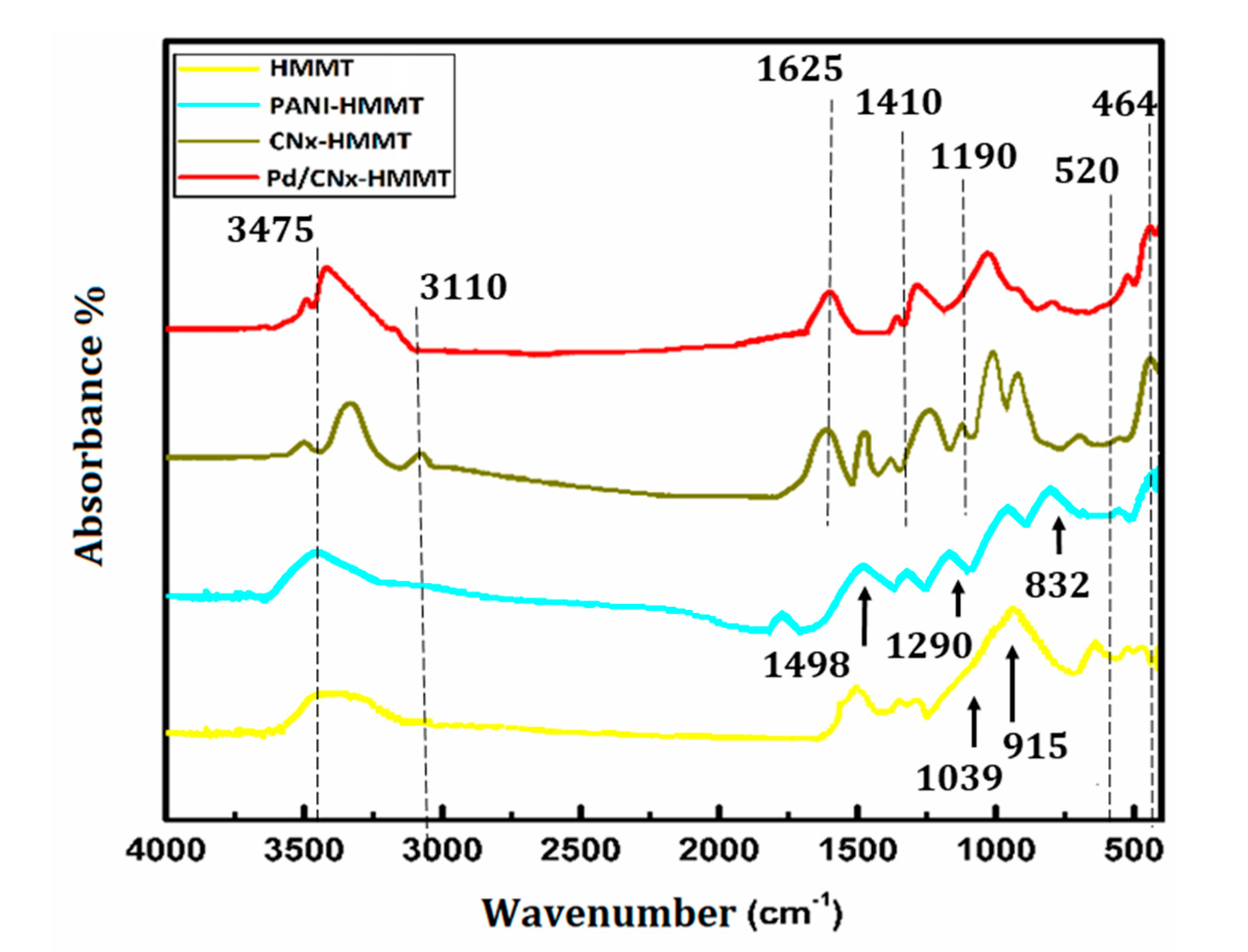
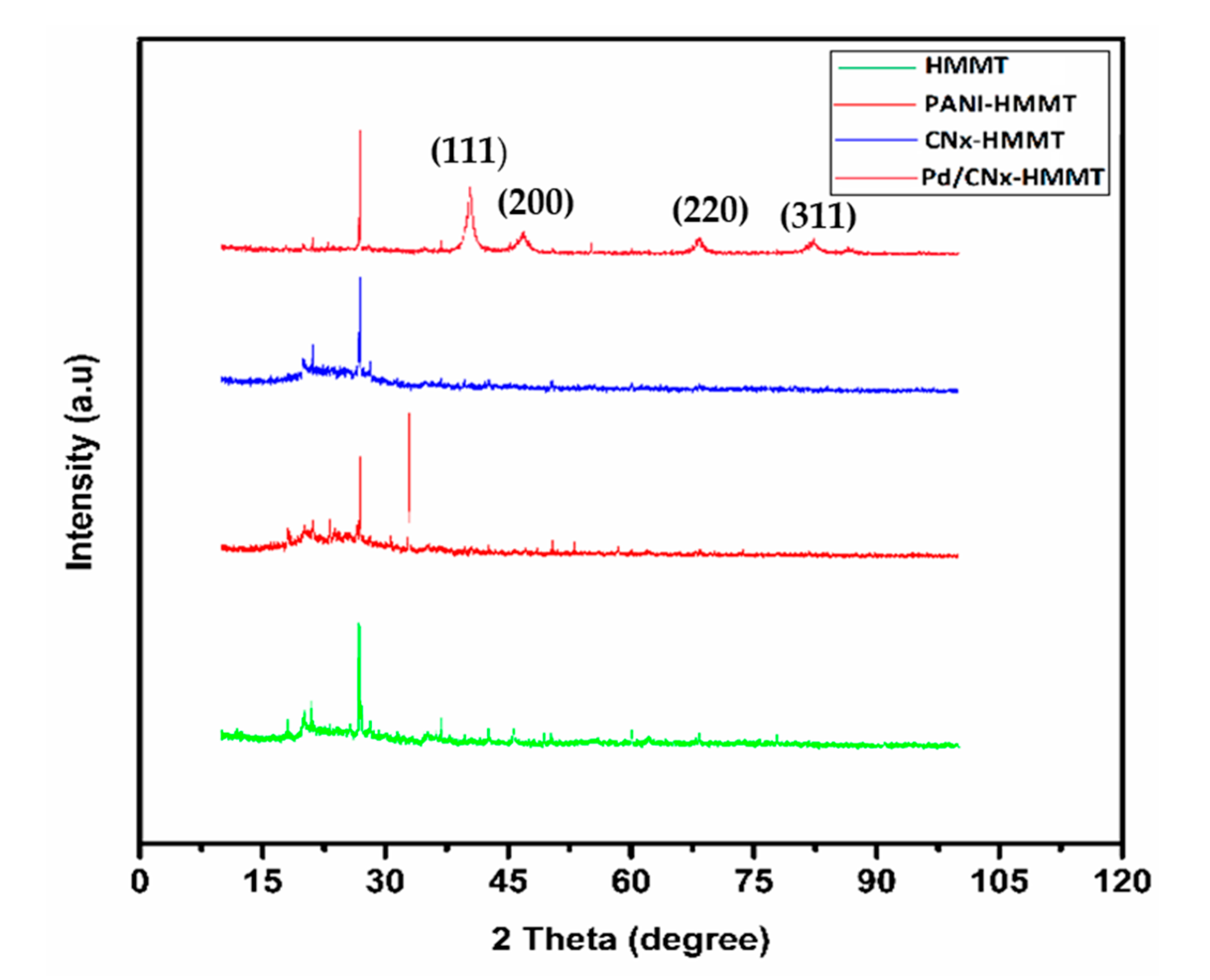
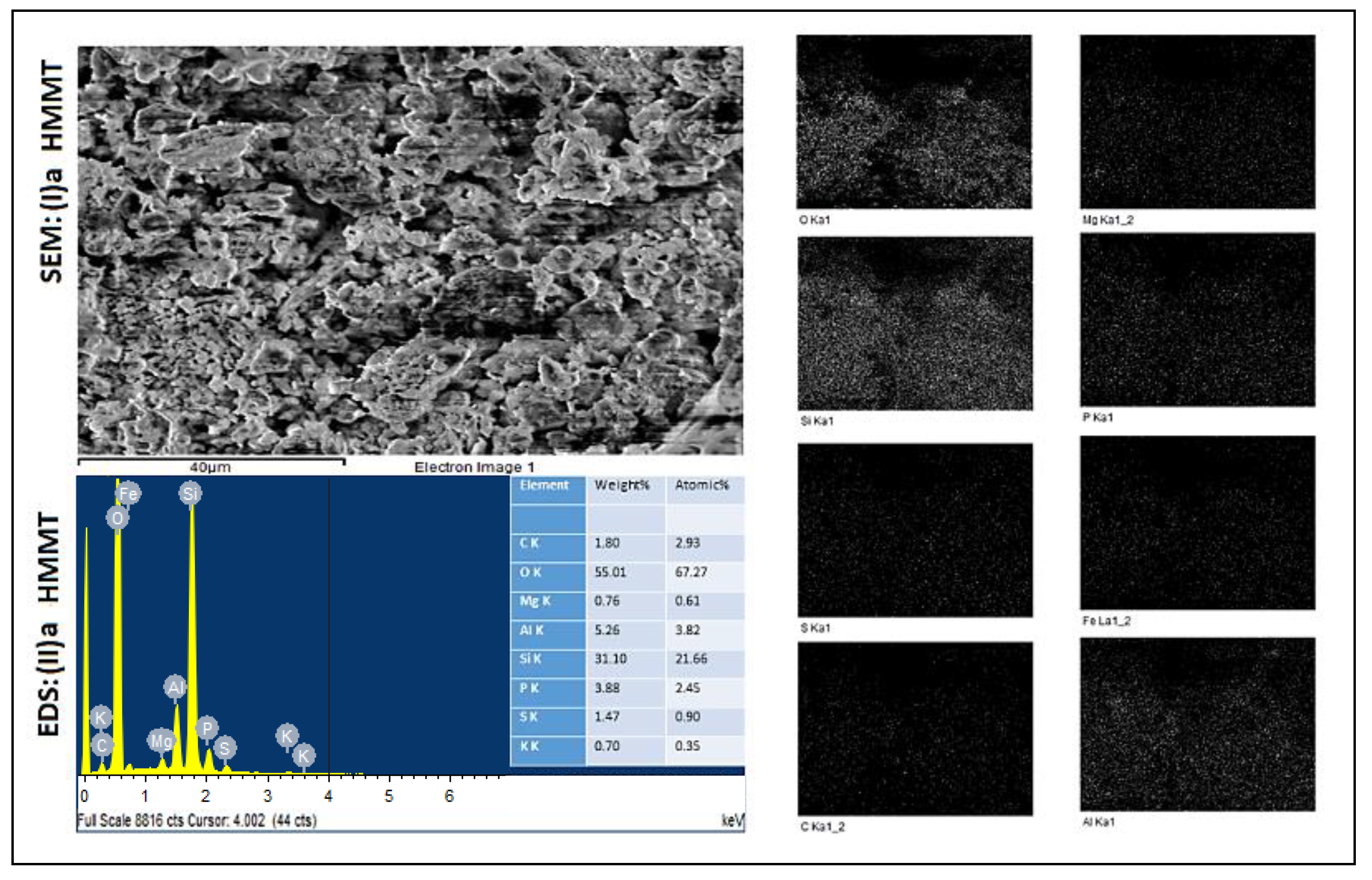



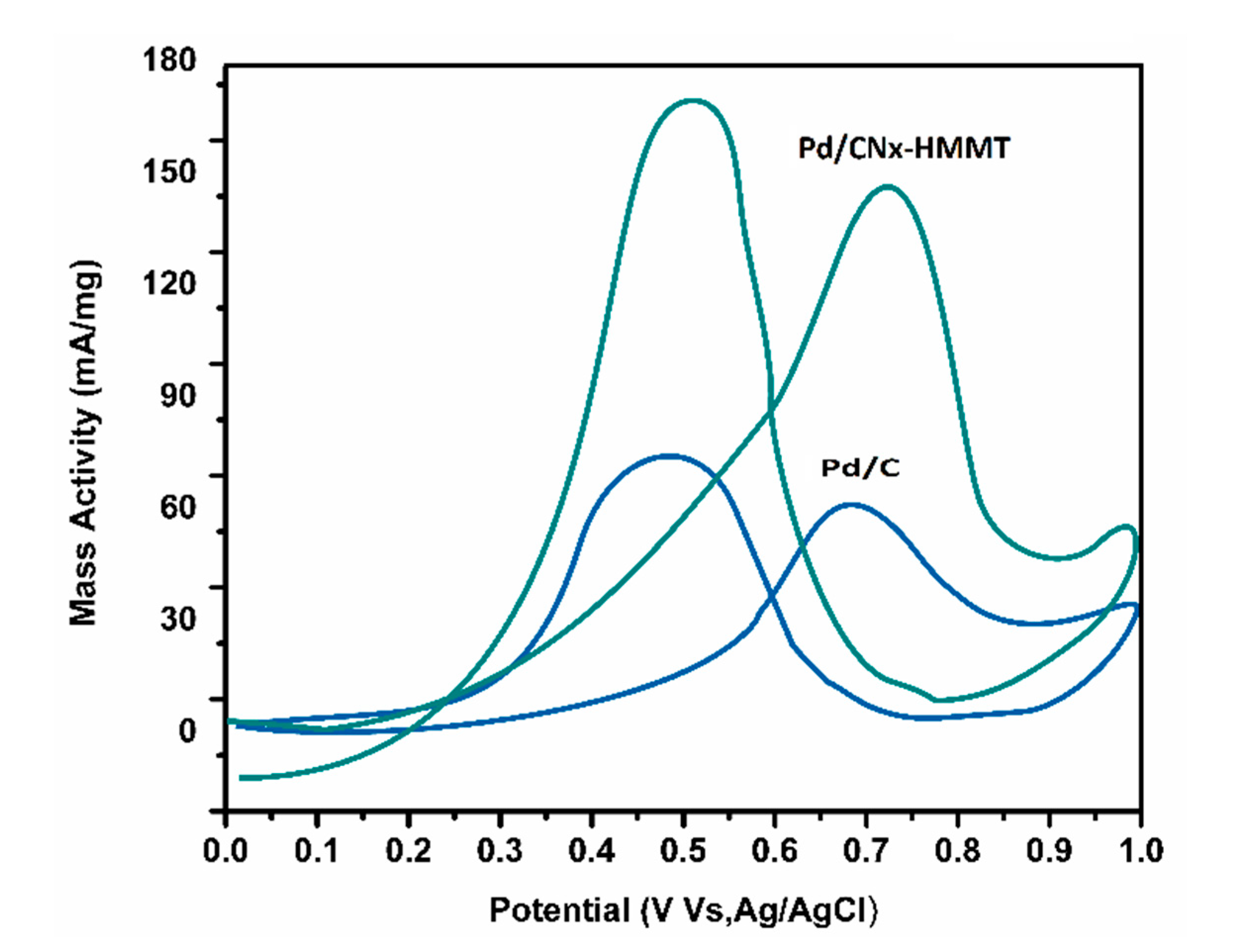
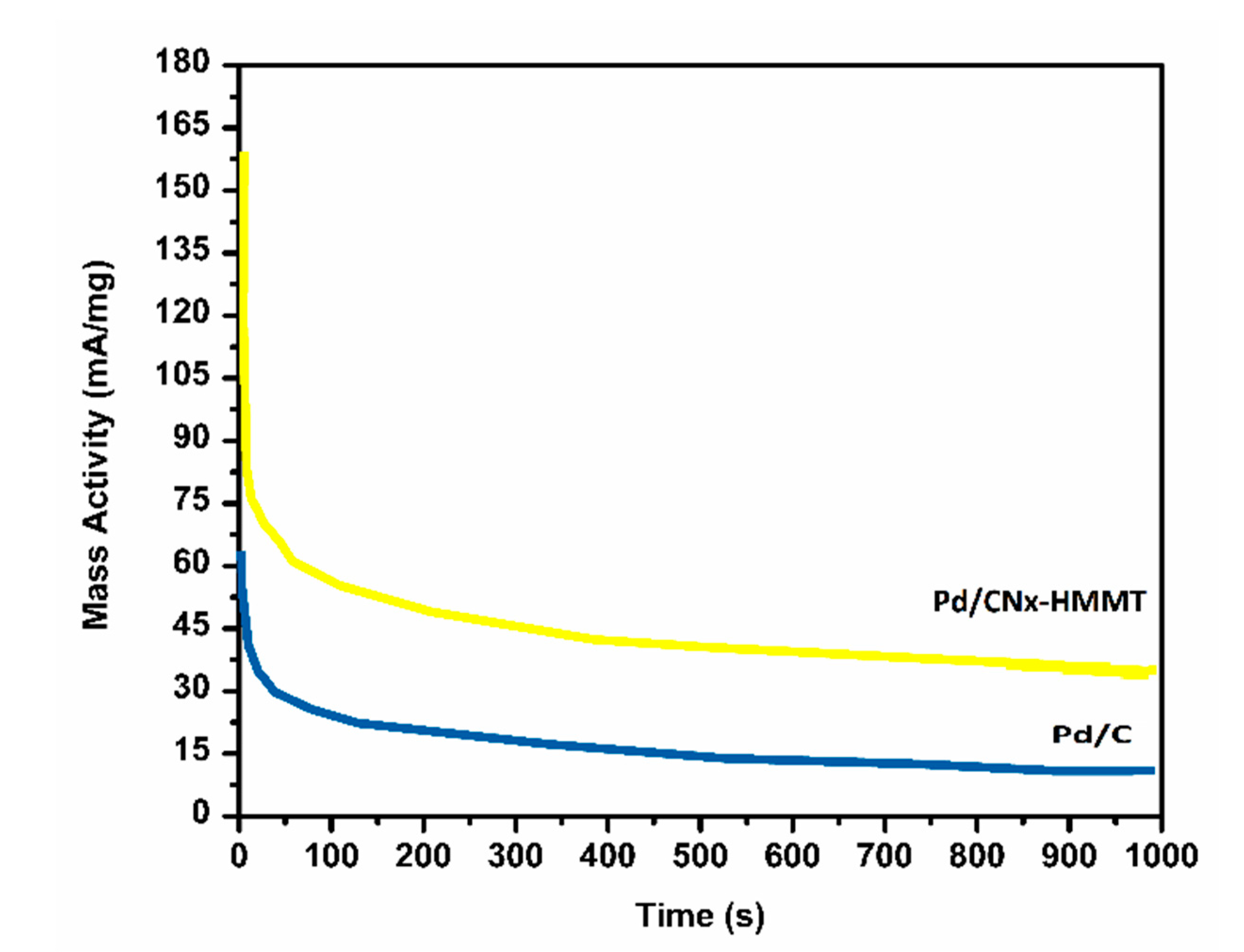
| Catalyst | Onset Potential, V | Forward Peak Potential, V | If/Ib | References |
|---|---|---|---|---|
| Pt/C | 0.35 | 0.67 | 0.83 | [52] |
| Pt/TiO2@C-900 | 0.25 | 0.77 | 0.62 | [53] |
| Pt/Vulcan XC-72R | 0.25 | 0.72 | 0.49 | [53] |
| Pt/C40-CeO2 | 0.35 | 0.71 | 0.86 | [54] |
| Pd/CNx-MMT | 0.12 | 0.73 | 0.88 | This work |
| Pd/C | 0.28 | 0.67 | 0.82 | This work |
Publisher’s Note: MDPI stays neutral with regard to jurisdictional claims in published maps and institutional affiliations. |
© 2021 by the authors. Licensee MDPI, Basel, Switzerland. This article is an open access article distributed under the terms and conditions of the Creative Commons Attribution (CC BY) license (https://creativecommons.org/licenses/by/4.0/).
Share and Cite
Altaf, F.; Gill, R.; Bocchetta, P.; Batool, R.; Hameed, M.U.; Abbas, G.; Jacob, K. Electrosynthesis and Characterization of Novel CNx-HMMT Supported Pd Nanocomposite Material for Methanol Electro-Oxidation. Energies 2021, 14, 3578. https://doi.org/10.3390/en14123578
Altaf F, Gill R, Bocchetta P, Batool R, Hameed MU, Abbas G, Jacob K. Electrosynthesis and Characterization of Novel CNx-HMMT Supported Pd Nanocomposite Material for Methanol Electro-Oxidation. Energies. 2021; 14(12):3578. https://doi.org/10.3390/en14123578
Chicago/Turabian StyleAltaf, Faizah, Rohama Gill, Patrizia Bocchetta, Rida Batool, Muhammad Usman Hameed, Ghazanfar Abbas, and Karl Jacob. 2021. "Electrosynthesis and Characterization of Novel CNx-HMMT Supported Pd Nanocomposite Material for Methanol Electro-Oxidation" Energies 14, no. 12: 3578. https://doi.org/10.3390/en14123578
APA StyleAltaf, F., Gill, R., Bocchetta, P., Batool, R., Hameed, M. U., Abbas, G., & Jacob, K. (2021). Electrosynthesis and Characterization of Novel CNx-HMMT Supported Pd Nanocomposite Material for Methanol Electro-Oxidation. Energies, 14(12), 3578. https://doi.org/10.3390/en14123578







